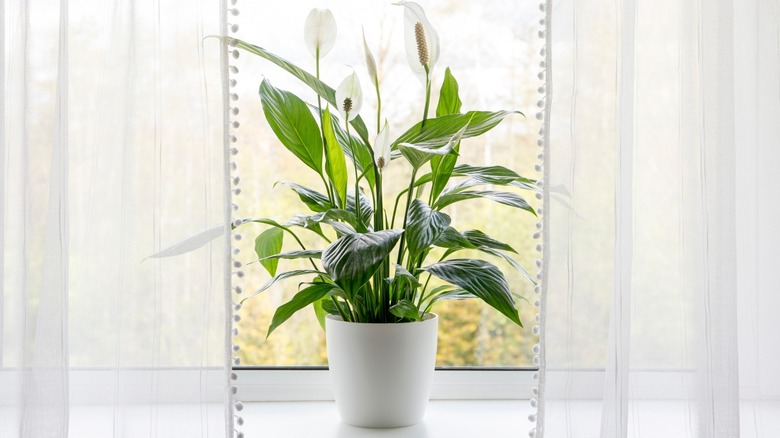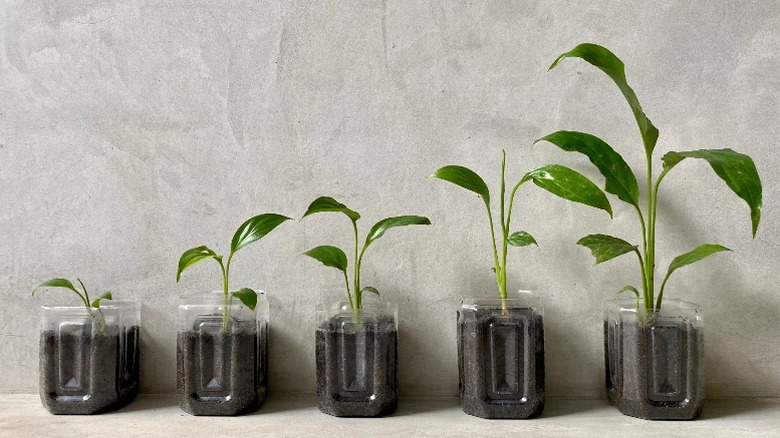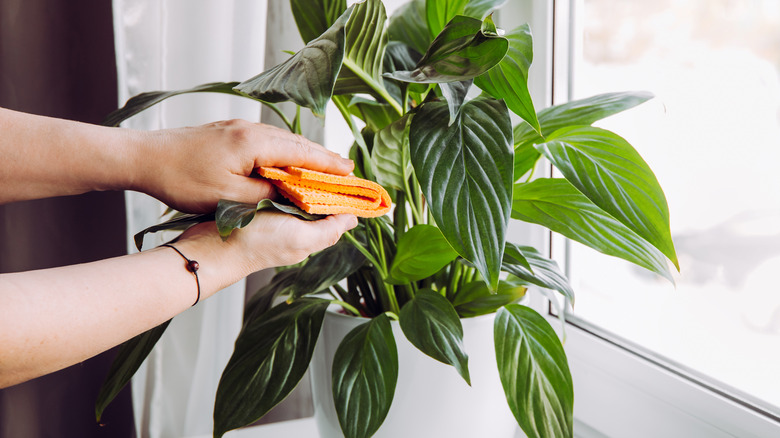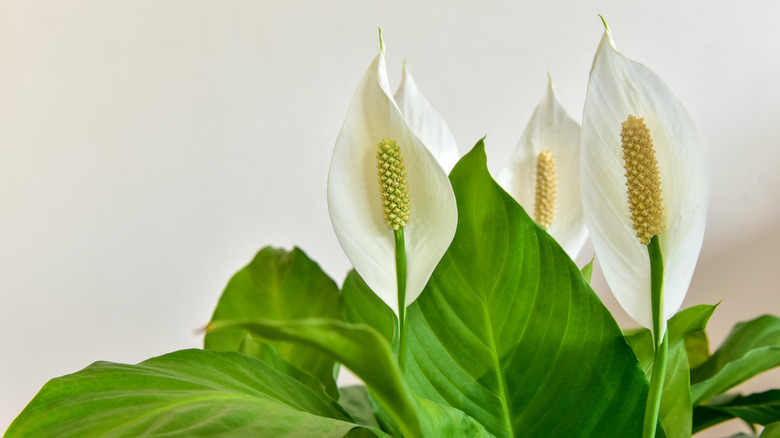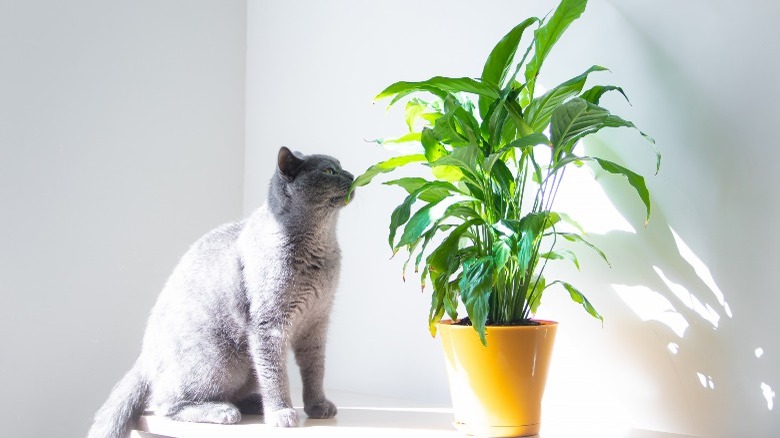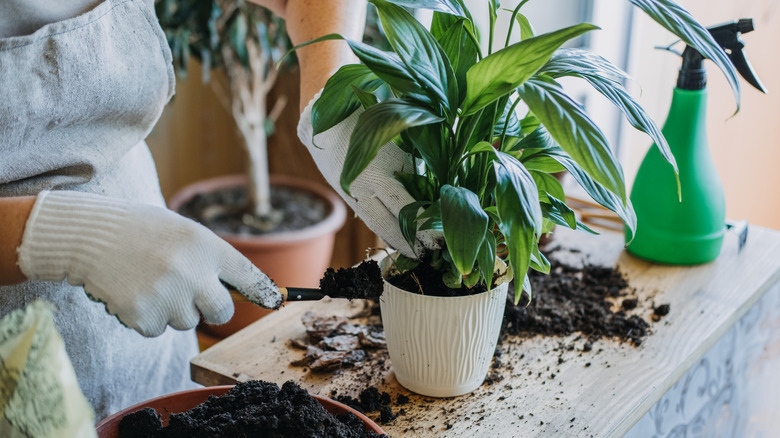How To Successfully Grow An Indoor Peace Lily Plant
Indoor plants add a touch of botanical delight to any room in the house. In fact, studies cited by Healthline have shown that having plants in your home has several therapeutic advantages, including improving indoor air quality, reducing stress levels, and promoting a more positive outlook. That could be why so many of us turn to the soothing space of the garden to relax and recharge. So for those of us who love the outdoors (and especially anyone living in colder climates) why not expand those benefits and bring the beauty of the outdoors inside our home?
The aptly-named Peace Lily is a great plant for this purpose. Belonging to the genus Spathiphyllum, it is a popular houseplant known for its elegant white flowers and waxy dark green foliage. According to Clemson University Cooperative Extension, it has a relatively long blooming season and is one of the rare flowering species that will blossom in low-light conditions. It is among the easiest houseplants to grow and requires minimal maintenance. Let's explore some tricks and tips on how to keep this showstopper plant happy and healthy in your home!
How to grow a Peace Lily plant
Peace lilies thrive best in conditions that closely mimic the tropics of their native habitat. More specifically, this means they require adequate humidity and should be placed in indirect sunlight, as The Old Farmer's Almanac explains. If growing your peace lily indoors, plant it in well-draining potting soil in a container with drainage holes to avoid excessively wet conditions that can lead to root rot. Peace lilies actually prefer a more snug fit in their container, but watch carefully that it does not become overly root-bound.
As your peace lily grows, it can be propagated by division to give you additional plants. According to Happy Sprout, you start by identifying the "mother plant" or the clump with the largest stem and then locate smaller clumps or "crowns" that surround it. Only crowns with three leaves or more will be hardy enough for transplant. After removing the plant from the pot, use a spade to separate the crown roots from those of the main plant. Plant the crown in a new pot, and give it the same care and conditions to reduce the risk of transplant shock.
How to care for a Peace Lily plant
Proper care of your peace lily is the best way to ensure its long-term health and beauty in your indoor space. A healthy plant will more quickly reach its mature height, better resist pests and disease, and more frequently produce stunning blooms for you to enjoy. You should keep in mind that the plant prefers warmer temperatures ranging from 60 to 80 degrees Fahrenheit, as Clemson Education Extension notes that it hails tropical environments. To provide your plant with sufficient humidity, you will need to mist it in addition to regular watering. Allow the soil to dry out slightly between waterings. If your plant looks sad, don't fret — a dose of water will perk it back up in just a few hours. However, overwatering can cause issues such as fungus or root rot, so take care to strike an appropriate balance for your plant.
The wide leaves of the plant tend to accumulate dust and debris. If you notice the foliage appears duller than you remember, give your plant a quick rinse in the shower or carefully wipe it down with a dust cloth. In addition to restoring the plant to its attractive, glossy appearance, it will also help the plant better absorb the bright, indirect light it needs to grow. Peace lilies require little fertilizing, and The Old Farmer's Almanac advises dosing only every 6 weeks or so. Excessive nutrients can overwhelm the plant and cause the foliage to brown.
Peace Lily plant varieties
According to the Clemson Cooperative Extension, there are over 40 different known species of peace lily belonging to the genus Spathiphyllum. In their natural habitats in the tropical regions of Central and South America, they thrive in the humidity and partial sunlight of the forest floor. In warmer, sub-tropical regions of the U.S., they can be grown outdoors as a perennial, but they are much more commonly grown as indoor houseplants. The Old Farmer's Almanac lists some of the most popular varieties:
- Spathiphyllum 'Starlight' is a dwarf variety, named for its glossy, emerald green color that really shines in spite of its small size.
- Spathiphyllum 'Mauna Loa Supreme' grows to just a few feet tall, but bears larger, striking flowers that emerge from long stalks.
- Spathiphyllum hybrid 'Domino' is prized for its variegated, ruffled white and green foliage that sets it apart from other varieties.
- Spathiphyllum 'Little Angel' is a petite variety that only grows to be a foot or so tall, but makes an impact with its frequent and abundant blooms.
- Spathiphyllum 'Sensation' stakes claim as the largest variety, its sturdy form reaching an impressive 6 feet in height and breadth.
Are Peace Lily plants toxic?
Though it makes a beautiful accent in any room, your peace lily has an element of underlying danger that you may not be aware of. Unfortunately, the Peace Lily has high toxicity. According to North Carolina Cooperative Extension, the leaves contain poisonous calcium oxalate crystals. The good news is that merely touching the foliage will not yield any negative effects, but ingestion of the leaves in large quantities can be harmful to both humans and pets. A poisoned individual may experience pain in and around the mouth and throat, drooling, and vomiting.
Because the foliage is prone to dropping off, the toxic leaves can easily fall into the reach of pets or children. Take care to avoid this by warning all household members and visitors, pruning your plant regularly, and placing it entirely out of reach of vulnerable people and animals. If you even suspect that you or someone else may have ingested part of the plant, contact Poison Control immediately at 1-800-222-1222 and reach out to a medical professional, especially if the aforementioned symptoms begin to present.
How to repot a Peace Lily plant
According to Simplify Plants, peace lilies grow relatively quickly– up to half a foot annually, allowing them to reach their maximum height in just a few years. Of course, this differs among varieties, so be sure to take your plant's particular characteristics into account. Given the growth rate, you will likely have to repot in a larger container from time to time. This is also a good time to divide your plant if you wish.
To repot your peace lily, start by selecting a slightly-larger pot with good drainage that is sturdy and easy to move. You should use a nutrient-dense potting mix that contains organic materials such as sphagnum, perlite, and peat moss. Gardener's Path recommends watering your peace lily the day before you intend to repot to reduce stress on the plant. Remove the plant from its existing pot, and place it in the new pot with the top of the root ball just below the rim. Fill any gaps with soil, and water thoroughly.
